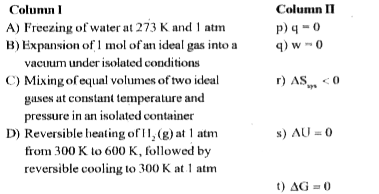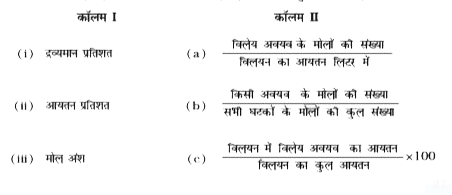Match the thermodynamic processes given under Column I with expressions given in Column II
 Solution in Malayalam
Solution in Malayalam
B−p,q,sC−p,q,sD−p,q,s,t
During freezing of water entropy decrease, ΔSsys<0,ΔG=0. In vacum, free expansion work done =0So,q=0andΔU=0
For an ideal gas in isolated condition q=0,ΔU=0, so as per first law w=0.
The process is cycolic through unique reversible path, hence ΔH=0 (cyclic), ΔG=0.
w = 0 (positive and negative work are same and oppostie ) and q =0.
Topper's Solved these Questions
- CHEMICAL THERMODYNAMICS BOOK - BRILLIANT PUBLICATIONCHAPTER - CHEMICAL THERMODYNAMICS EXERCISE - LEVEL-II (Assertion-Reason Type)
18 Videos
- CHEMICAL BONDING AND MOLECULAR STRUCTUREBOOK - BRILLIANT PUBLICATIONCHAPTER - CHEMICAL BONDING AND MOLECULAR STRUCTUREEXERCISE - QUESTION (LEVEL -ll)
42 Videos
- CLASSIFICATION OF ELEMENTS AND PERIODICITY IN PROPERTIESBOOK - BRILLIANT PUBLICATIONCHAPTER - CLASSIFICATION OF ELEMENTS AND PERIODICITY IN PROPERTIESEXERCISE - QUESTIONS (LEVEL-III ( Linked Comprehension Type ))
12 Videos
Similar Questions
Assertion : Heat of neutralisation of HNO3, and NaOH is almost same as that of HCl and KOH.
Reason : Both HNO3, and HCl are strong acids and NaOH and KOH are strong bases. : if both (A) and (R) are correct and (R) is the correct explanation of(A)., If both (A) and (R) are correct, but (R) is not the correct explanation of(A)., If(A) is correct, but (R) is incorrect., If both (A) and (R) are incorrect.
View SolutionWhich of the following species are hypervalent ?
(l) ClO−4
(ll) BF3
(lll) SO2−4
(lV) CO2−3
View SolutionThe heats of formation (ΔH∘f) of the oxides of the third period, sodium to chlorine, are in kJ mol−1

Based on these data, answer the following questions
Which oxide has maximum negative heat of formation per oxygen atom?
View SolutionMatch the thermodynamic processes given under column I with the expressions given under column II.
View SolutionMatch the catalyst given in Column I with the processes given in Column II.
View SolutionMatch the catalyst given in Column I with the processes given in Column II.

View Solutionस्तम्भ I में दिए गए ऊष्मागतिक (thermodynamic) प्रक्रमों को स्तम्भ II में दिए गए व्यंजकों से सुमेलित करें।

View SolutionMatch the process given in column I with its description given in column II.
View SolutionMatch the nuclear processes given in Column I with the options given in Column II.
View SolutionMatch the catalyst given in Column I with the processes given in Column II.

View SolutionMatch the statements/expressions given in Column I with the values given in Column II.

View SolutionMatch the statements/expressions given in Column I with the values given in Column II.

View Solutionकॉलम I में दिए गए वत्तक़व्यों/व्यंजकों का कॉलम II में दिए गये मानो से सुमेल करें

View Solutionकॉलम I में दिए गए वत्तक़व्यों/व्यंजकों का कॉलम II में दिए गये मानो से सुमेल करें

View Solutionकॉलम I में दिए गए नियम को कॉलम II में दिए गए व्यंजक से सुमेलित कीजिए

View Solutionकॉलम I में दिए गए मदों को कॉलम II में दिए गए व्यंजकों से सुमेलित कीजिए -


View Solution
